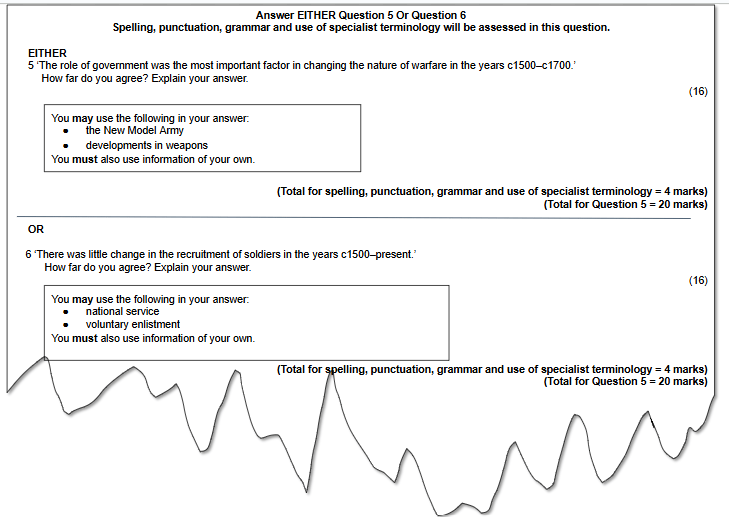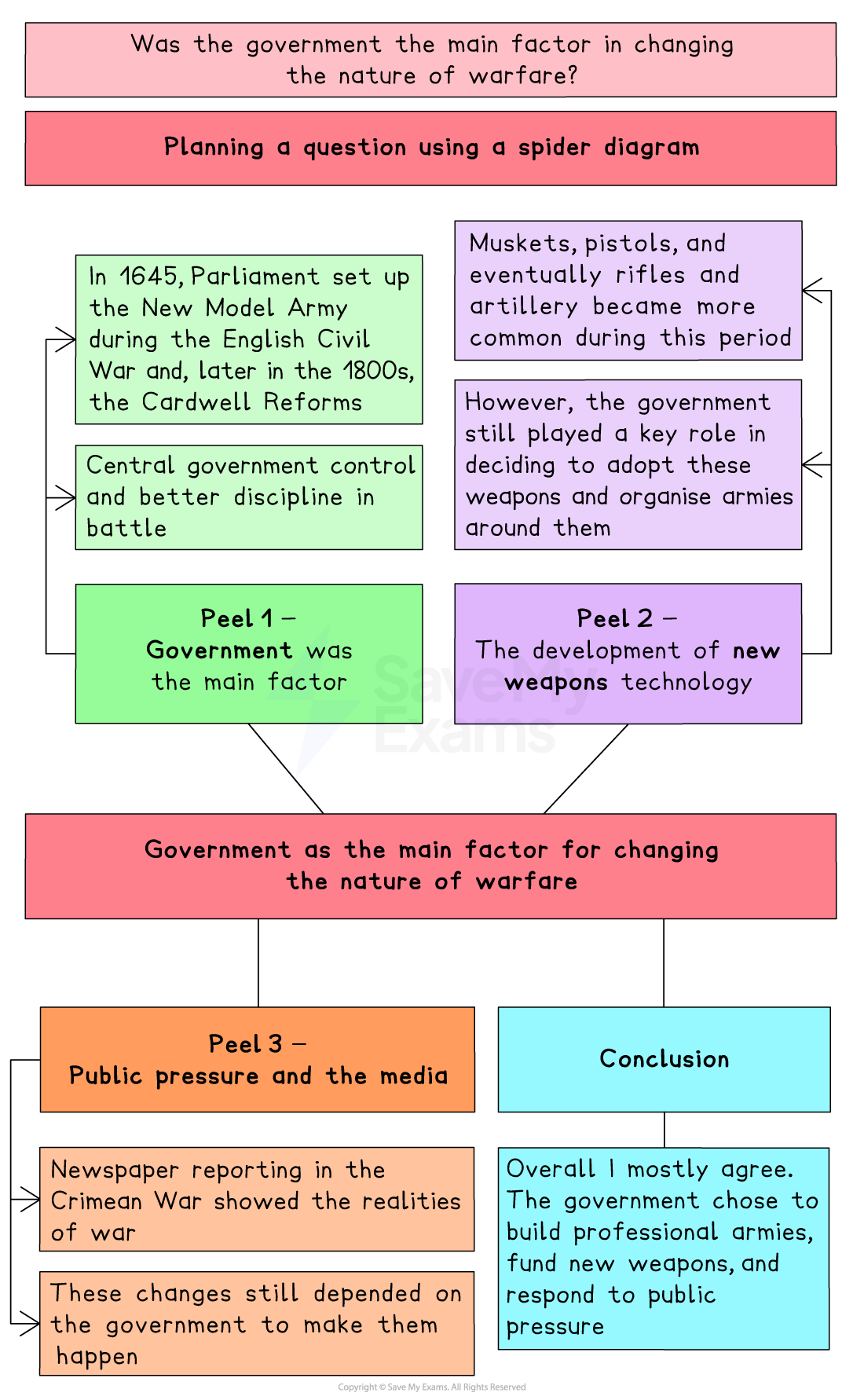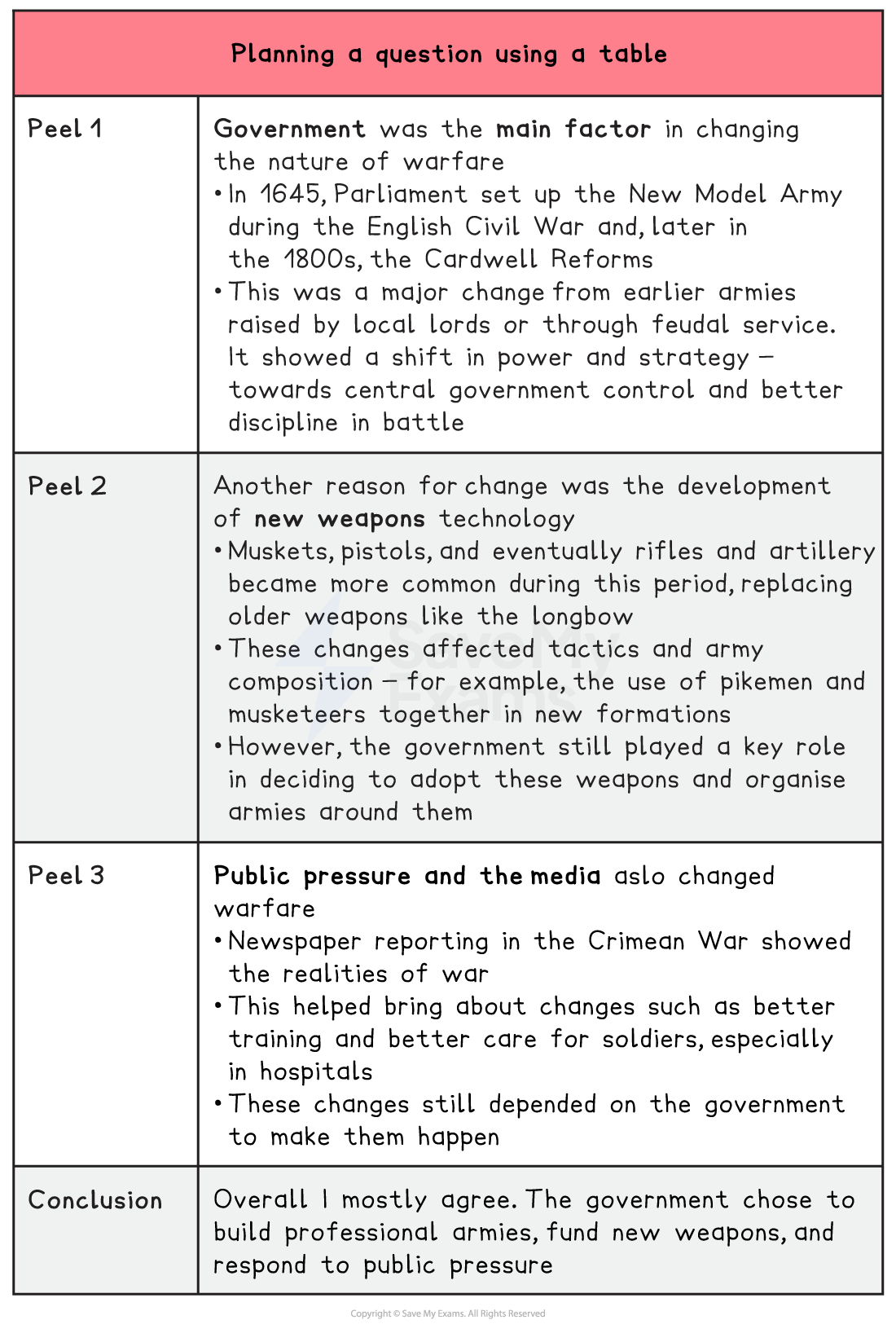The 16 Mark "How Far Do You Agree" Question (Edexcel GCSE History): Revision Note
Exam code: 1HI0
Summary of Question 5 or 6
You will choose either Question 5 or Question 6
Answering either question requires you to:
Make a clear, sustained judgement about a historical statement
Use second-order concepts such as cause, change, significance or consequence
Compare the given reason with other valid reasons
Reach a well-structured conclusion
From the 2025 exams onwards, the question will cover either a complete period or at least 200 years
Amount of marks | 16 + 4 SPaG marks |
|---|---|
The time that you should spend on the question | 5 minutes of planning 20 minutes of writing |
An example of the type of question you may encounter can be seen below:

In previous years, this question has focused on the following topics in Warfare in British society:
Year of Exam | Question Topic |
|---|---|
2018 (opens in a new tab) | Question 5: The development of new weapons affecting recruitment, c1250–c1700 Question 6: Change in the nature of warfare, c1700–1900 |
2019 (opens in a new tab) | Question 5: Changes in the nature of warfare in the periods c1500–c1700 to c1700–c1900 Question 6: The development of war reporting affecting attitudes towards war, c1800–present |
2020 (opens in a new tab) | Question 5: Changes in the composition of the army, c1500–c1700 Question 6: Cardwell’s army reforms affecting recruitment and training, c1800–present |
2021 (opens in a new tab) | Question 5: The use of gunpowder affecting the nature of warfare, c1250–c1700 Question 6: Specialist groups affecting the composition of the army, c1700–present |
2022 (opens in a new tab) | Question 5: The role of the commander affecting the outcome of a battle, c1250–c1500 Question 6: The organisation of a Home Front affecting civilian experience, c1700–present |
2023 (opens in a new tab) | Question 5: The Battle of Naseby as a turning point in the nature of warfare, c1500–c1700 Question 6: The rifle's impact on warfare, c1700–present |
2024 | Question 5: The development of new weapons affecting the nature of warfare, c1250–c1500 Question 6: Developments in artillery affecting the composition of the army, c1500–c1900 |
Making judgements in history
The 16-mark question requires you to weigh all the evidence and make a decision
Students often find this part the hardest to do
Common mistakes in judgement questions
Explaining that all of the reasons are the most important
Avoiding a clear decision by using phrases like “kind of” or “maybe”
Giving no opinion
Changing your argument halfway through
In the example question, you state that the government was the most important factor in changing the nature of warfare
However, in the conclusion, you state that the development of weapons was the most important factor
Doing this means that there is not a sustained judgement, and you can not access Level 4 (13–16 marks)
What makes a good judgement?
Clearly answer the question clearly using second-order concepts
Acknowledge other sides of the argument
Have a consistent judgement from start to finish
Use your best evidence to back up your decision
There is no "right" or "wrong" answer in history
Consider other reasons
Even if you fully believe a reason is the most important, you still need to present evidence for other reasons
What makes a great conclusion in GCSE History?
Conclusions are usually where most of your judgement marks will be awarded
All great conclusions have these three elements:
Judgement — State your opinion using words from the question
Counter — Mention a reason from the other side
Support — Use your strongest evidence to explain why your side is more convincing
How to get SPaG marks
In Paper 1, students have access to an additional 4 marks for answering either Question 5 or 6
This is awarded for SPaG (Spelling, Punctuation and Grammar)
SPaG mark | Reason for this mark |
|---|---|
0 |
|
1 |
|
2-3 |
|
4 |
|
Top tips for boosting SPaG marks
Spell historical terms correctly
Use paragraphs
Re-read your work for punctuation
Read the answer in your head
Where you would take a breath, make sure there is a comma or a full stop
How to answer a "How far do you agree?" question
In the exam, only answer either Question 5 or Question 6
You should put an "X" in the box next to the question you have chosen to answer

You will receive two stimulus points
These are areas of knowledge to discuss in your question
If you only discuss these two stimulus points, you are limited to a maximum of 11 marks
You can choose not to use any of the suggestions
You can still achieve full marks by not using the two stimulus points
You must discuss three areas of knowledge in your answer to access Level 4
To answer this question successfully, you should:
Read the answer carefully and multiple times
Annotate the question to find the key demands of the question
Plan your answer, including:
What your judgement is
The key knowledge you wish to use


"How far do you agree?" question structure
Your answer should include:
A logical structure
A range of specific and relevant knowledge
An explanation of the second-order concept outlined in the question
A clear and sustained judgement throughout the answer
A conclusion
If you want to include an introduction, you can, but it is not necessary
Your answers could be written in PEEL paragraphs:
P — Make a point about the question
This should include your judgement
E — Use evidence that supports the point that you have made (K)
Evidence needs to be relevant and specific to the question
E — Explain why this evidence supports your point
Your explanation should be focused on the second-order concept outlined in the question (SOC)
L — Link your explanation back to the question to help sustain your argument and show your understanding of the question
The question is out of 20 marks:
6 marks for a wide range of specific knowledge of the period and the topic stated in the question (K)
10 marks for the analysis of the key second-order concepts of cause and consequence, similarities and differences, and importance (SOC)
4 marks are awarded for Spelling, Punctuation and Grammar (SPaG)
Worked example of a "How far do you agree?" question
Worked Example
"The role of government was the most important factor in changing the nature of warfare in the years c1500–c1900."
How far do you agree? Explain your answer.
(16 + 4SPaG)
You may use the following in your answer:
You must also use information of your own. |
Answer
I agree with the statement that the government was the most important factor for changing the nature of warfare in the years c1500-c1900. However, other factors such as new weapons and the growth of public pressure did contribute significantly to the changing nature of warfare.
One reason why warfare changed between c1500 and c1900 was because of government decisions. In 1645, during the English Civil War, Parliament created the New Model Army. This was the first full-time, professional army in England. It had regular pay and training, and soldiers were promoted based on skill, not their background. Later in the 1800s, the government brought in the Cardwell Reforms (K). These actions helped make the army more professional. This shows that the government had a big role in changing how armies were made and how they worked. Without government support, these changes wouldn’t have happened (SOC).
Another reason for the change was new weapons. In the early part of this period, weapons such as the longbow and cannon were common, but over time, gunpowder weapons became more powerful. Muskets and pistols became widely used by soldiers in the 1600s. By the 1800s, these had been replaced by rifles, which were more accurate and could fire further. The army also began using new artillery (K). These changes made battles more deadly and changed how armies fought. Although these weapons were invented by scientists and engineers, it was the government that bought them and trained soldiers to use them. Therefore, even though weapons were important, they needed government action to make a real difference (SOC).
A third reason for change was the growth of public pressure and the media. During the Crimean War, newspaper reports and photographs showed people in Britain how badly the war was being run. This led to criticism of the army and pressure on the government to improve (K). This helped bring about changes such as better training and better care for soldiers, especially in hospitals. The opinions of ordinary people began to shape how wars were fought. However, these changes still depended on the government to make them happen. This means that public opinion did matter, but it was not as powerful as government decisions in changing warfare (SOC).
In conclusion, I agree that the role of government was the most important factor in changing warfare between c1500 and c1900. Some people might say that new weapons or public opinion had more impact, especially with the rise of rifles and the media in the 19th century (SOC). However, it was the government that chose to build professional armies, fund new weapons and respond to public pressure. Therefore, it had the biggest role in shaping how warfare changed (SOC).

Unlock more, it's free!
Did this page help you?